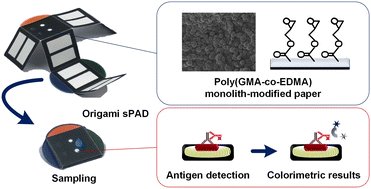Themed collection Paper-Based Point of Care Diagnostics

Dengue-virosensor: advancement of dengue virus-based biosensors
Novel literature covering advancements in the field of dengue diagnostics.

Sens. Diagn., 2025,4, 7-23
https://doi.org/10.1039/D4SD00262H
Paper-based point of care diagnostics for cancer biomarkers
Advancements in assay design, detection techniques, signal transduction and enhancement strategies using smart nanomaterials.

Sens. Diagn., 2024,3, 504-535
https://doi.org/10.1039/D3SD00340J
Paper sensors for the measurement of nitric oxide release from endothelial cells
Nitric oxide (NO) is a ubiquitous and important biological mediator.

Sens. Diagn., 2025,4, 310-319
https://doi.org/10.1039/D4SD00154K
Paper-based sensing of pancreatic-cancer biomarker α-chymotrypsin through turn-on lanthanide-luminescence
An inexpensive and robust paper-based sensor has been developed to detect pancreatic cancer biomarker α-chymotrypsin through turn-on visible light emitting Tb3+-luminescence for the first time.

Sens. Diagn., 2024,3, 1456-1460
https://doi.org/10.1039/D4SD00124A
Headspace paper-based analytical device for ammonia quantification in human biological samples
The simple and low-cost contact-less headspace paper-based colorimetric device (hPAD) was established for improving the selective detection of ammonia levels in human samples.

Sens. Diagn., 2025,4, 345-352
https://doi.org/10.1039/D4SD00361F
Leveraging synthetic imagery and YOLOv8 for a novel colorimetric approach to paper-based point-of-care male fertility testing
The development of paper-based systems has revolutionized point-of-care (POC) applications by enabling rapid, robust, accurate and sensitive biochemical analysis, infectious disease diagnosis, and fertility monitoring.

Sens. Diagn., 2025,4, 336-344
https://doi.org/10.1039/D4SD00348A
An approach to use machine learning to optimize paper immunoassays for SARS-CoV-2 IgG and IgM antibodies
Optimizing paper immunoassay conditions for diagnostic accuracy is often achieved by tuning running conditions in a trial and error manner. We report the use of machine learning to optimize an assay for SARS-CoV-2 IgG and IgM antibodies.

Sens. Diagn., 2024,3, 677-687
https://doi.org/10.1039/D3SD00327B
Monolith-modified cellulose paper for biochemical sensing applications
A microfluidic paper-based analytical device (μPAD) modified with a poly(GMA-co-EDMA) monolith for rapid tuberculosis detection.

Sens. Diagn., 2022,1, 994-1002
https://doi.org/10.1039/D2SD00108J
A wearable paper-integrated microfluidic device for sequential analysis of sweat based on capillary action
Soft, skin-mounted microfluidic devices can collect microliter volumes of eccrine sweat and are capable of in situ real-time analysis of different biomarkers to assess physiological state and health.

Sens. Diagn., 2022,1, 775-786
https://doi.org/10.1039/D2SD00032F
About this collection
In recent years, the need for accessible, affordable, and reliable diagnostic methods has become increasingly critical, especially in low-resource settings. The advent of paper-based point-of-care (POC) diagnostic platforms has emerged as a promising solution to meet this demand. This collection aims to explore the advancements, challenges, and future directions in developing and applying paper-based POC diagnostics. It highlights innovative designs, materials, and technologies that enhance the functionality, sensitivity, and specificity of these platforms. Additionally, it covers integration of paper-based systems with digital health technologies for data analysis and remote health monitoring, contributing to the advancement of telemedicine and decentralized healthcare.
Guest Editors: Thiago Paixão (Universidade de São Paulo, Brazil), Daniel Citterio (Keio University, Japan) and Willam de Araujo (Universidade Estadual de Campinas, Brazil)